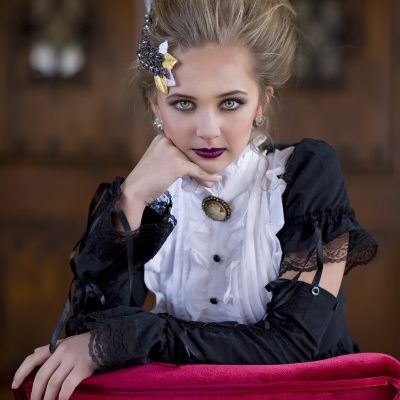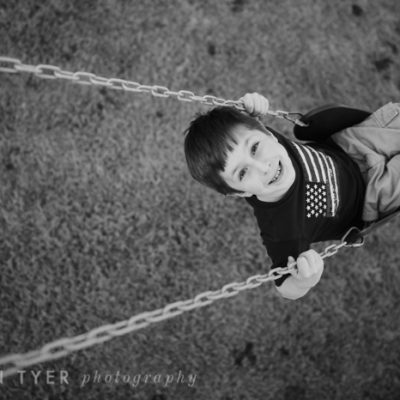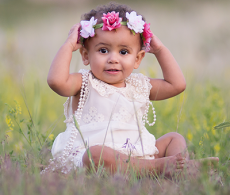by Guest Contributor Elizabeth Halford
With the ability to liquify 20 lbs off in Photoshop, shine up eyes to oblivion and make skin more perfect than Barbie, sometimes capturing the image in your camera is just a tiny fraction of the work that can actually go into producing a magazine-esque portrait.
Before I knew anything about photography, my husband and I had our yearly photo sessions with a popular studio photographer in our city. He covered my pregnancies and our growing family year after year. I have a little birth mark on my lip. It’s kind of like a little bump you get when your purse your lips. When we got our first images back, I was so oblivious to the process of photography and editing that I thought I looked amazing and didn’t ever consider the fact that it was done in Photoshop. I just figured that I actually looked that good or that he just had a really good camera. Until I noticed that my birth mark was gone. I don’t mind my birth mark. It’s part of my face, not a temporary intruder like a zit or a bruise. But no one had asked me if I wanted it removed.
In the end, I didn’t mind enough to say anything, but it’s the example I think about when a reader posed me with the question that inspired this post: are our clients prepared for their transformation?
I know that not all photographers go for a hyper real, super edited look but even the most simple of adjustments can either thrill or annoy your client. Here are a few examples of my retouching techniques:
- I once had a rather large bride whose dress pushed everything…well…up. I think you call it ‘back cleavage’. But since it was on her back and she wouldn’t have been particularly aware of it’s presence, I took care of it in Photoshop. I didn’t intend on being unrealistic. I didn’t take weight off, but I did smooth out a couple of rolls which she may not have known were even there.
- Acne is pretty much always an ok thing to remove. If it’s not a permanent fixture – part of someone’s style or identity – I always assume it’s ok to remove it. This includes bruises, zits, acne scars…
- A staple of many photography businesses is the newborn session and often, this includes the new parents. I don’t know about you mums, but after having a baby, I’m always blissfully unaware of the actual state of my figure. Somehow, I think I’ve become skinny again overnight and it’s not until months later I look back and say what was I thinking?! In light of this, I’ve always found that I can give a little (keyword little) help to a new mummy’s post-partum figure without her even noticing.
- I almost always do a bit of touching under the eyes. Whether you’re a man or a woman, dark circles and bags are rarely a welcome part of your face. Even on children, they can be a huge distraction but tread lightly with editing children. I happen to know that for my son and some other kids, springtime photos will show darker under the eyes from allergies. But I don’t go all the way. I do the eyes before any other editing by duplicating the layer, applying a quick removal using the patch tool and then lowering the opacity of the layer by half. This means that half of the under eye area still shows through, but it’s just not as puffy or dark.
- Now, who made the rule that men are more attractive as they age? If you have that guy’s address, let me know. I rarely fix signs of aging in men. Using the above tip, I will sometimes soften the look of wrinkles or 5 o’clock shadow, but I don’t make his face look flawless.
- My favorite tool for retouching skin in Photoshop is from Totally Rad and it’s called ‘Pro Retouch’ you can just paint pores pretty! And when I was an Elements only type’a gal, I used MCP’s Magic Skin actions. Also, the adjustment brush in Lightroom is a pretty rockin tool for softening skin.
If I’ve said it once, I’ve said it a hundred times: expectation management is the numero uno most important thing to establish for resulting in happy clients. If they can clearly tell what you do and what they can expect by looking at your portfolio and website, then they won’t be surprised with the results of their session (as long as you haven’t deviated from your usual style). Obviously, they won’t know that you’ve removed imperfections from someone’s face, but they will probably notice that everyone looks pretty darn good through your camera. You might even be so brave as to add a little B&A somewhere on your website (like the FAQ section) to show people how fab you can make them look if they hire you!
Now, there are a million-and-one things you can talk to a client about in your pre-session consults. Location, wardrobe, style. And if you want to add another item to that list, you could talk about their feelings towards retouching. However, be careful…because like I mentioned in a post on dPS last week, you might want to carefully reconsider bringing up the word ‘Photoshop’. The instant you do, folks will light up with the possibilities of a Kim Kardashian-esque transformation and before you know it, you have a gigantic list of things they’d like you to take care of in your magic computer. Instead, talk to them about their body image. Ask them what they love about themselves and what they don’t love (but don’t make promises about fixing them). If this doesn’t come up naturally in conversation, it might happen during the session somehow and if it never does, don’t worry. Just follow your instincts.
I find it particularly helpful to pay close attention to your clients’ reactions during the viewing session. If they look confused, twist their face with distaste or mention that they don’t look like themselves, you can tell them that you did some light retouching and let them know that it can be re-worked in the prints that they actually want to purchase if they weren’t happy with their transformation.
We’re so lucky to be living in this technological age. We have every tool imaginable at our disposal for producing flawless, amazing and life-changing imagery. Sometimes, it’s best to leave things raw and real, sometimes you can go to town making a client look flawless. Test the waters and see what happens and remember…there’s always ctrl+z to fall back on!

![]()
 About the Author: Elizabeth Halford is a professional photographer and blogger in Hampshire, England. She owns Glacier Cake Photography and a blog for photographers. Elizabeth is a second generation home educator and is, regrettably, quite addicted to Facebook.
About the Author: Elizabeth Halford is a professional photographer and blogger in Hampshire, England. She owns Glacier Cake Photography and a blog for photographers. Elizabeth is a second generation home educator and is, regrettably, quite addicted to Facebook.









Love this blog…great info and links…
Hello,
I came across your blog post as I was searching for photograher protocol. I recently had a photographer shoot almost 200 images for my web catalog (wedding dresses). She was excellent and I plan to use her again. The only issue is, her retouching is going to cost me just as much as the shoot ($1200). Is it “tacky” to let her know that I am going to go elsewhere to get the images retouched? Is it a must to have the same photographer who shoots the photos retouch them? This is my first photo shoot, so I really do not know standard procedure. At the same time, I do not want to offend her because I want to use her again. I am not trying to be cheap, but I am a small business and have a lot of other expenses to pay. Thank you and I like your blog! Julie
One of the things I always do is talk about removing skin blemishes with the client. I tell them that it is difficult to discern when a differently colored place is a pimple, a birthmark, or a mole (I shoot boudoir and portraiture). Then I ask if there are any marks that they don’t mind not removing. It usually starts the discussion about retouching and will give you a general idea of their attitude. Also, I never remove wrinkles, I only soften them. Create a new layer via copy and remove the wrinkles, then adjust transparency. It is simple and leaves a natural look.
@Julie: Was that quoted in the price? Retouching is part of the photography process. In my estimation, what she’s doing is like a chef plopping raw ingredients in front of you and asking you to pay more for him to cook them. If you don’t have a retoucher in mind, get in touch. elizabethhalford.com
Great article thank you somuch! When I go back and look at the first pictures I did im really embarrassed because I had just found out about the liquify tool & hadnt learned that less is more. definetly have to be careful & some people may not think they have side boob cleavage or that its a problem & might get offended by your makeover so its definetly wise to investigate your clients prefrences. About the retouching…..there are plenty of retouchers who dont do photography & lots of photographers that dont do retouching. I dont consider it a part of the process. I will promise a client X amount of edited images + unedited on a CD & if they want additional edited it costs extra. I dont think its tacky to go elssewhere but the photographer should have been CLEAR about what they planned on doing & not doing for that price and since they werent clear should offer a discount or something to keep a good reputation…sounds like a bait and switch
First off, my clients never see an unretouched image. *NEVER*! (Well, there is one: If the raw image holds no rude surprises, and they’ve already seen the retouched image, we might look at the raw images to see if they’d prefer a different pose. But that’s it.)
The reason I have this rule is that raw photography (and I’m using the word “raw” here as “unretouched”, not as in an unprocessed digital image) can make people look worse than they really are in real life, and therefore, I think photography can be brutal to someone’s self-image before we refine it to the point the person just looks “normal”. I define normal (and the way I explain retouching to my clients) as taking an image to the point that someone in a simple face-to-face conversation would remember you after the two of you had parted company.
I use that example because, absent any really striking (good or bad) features, during a conversation one is generally concentrating on the discussion, not on inspecting the other person’s face or other physical details. And if there are striking features (again, either good or bad) that one would recall, they’re going to be obvious, permanent features that you probably wouldn’t retouch away in any case.
That isn’t to say you might not work on those features, especially if they’re distracting. I often simplify or reduce things instead of completely getting rid of them: They get minimized that way, so it doesn’t appear unreal. But again, photography can over-emphasize some things, and I’m just taking it back a notch or two so it appears more “normal”–or maybe just a tad bit better than normal–but not so that someone would look at that feature and know it’s been reworked.
One other thing I **never** do though, is tell clients when I do rework something that’s a permanent feature, unless they’ve asked me specifically to do that work.
Most people are sensitive about their looks, and since they don’t really understand how this all works–that photography actually can make someone look worse than they appear in real life–we have a responsibility not to embarrass them, or even harm their self-opinion of their own looks: Ever hear someone look at a photo of themselves and ask (seriously, not jokingly), “Do I really look THAT bad??!!” Hopefully they haven’t said that about our images, but most of us have heard someone remark about an image of themselves that way.
People are well enough aware of their appearance from looking in the mirror all their lives. And if they like how they look, you never know how they’ll take it if you surprise them by telling them you had to work on this or that aspect of their person to get them to appear as good as they do, even if it was the camera angle, the lighting, etc, etc that was responsible, and that they really don’t look as bad as it seems, and “I can fix it for you anyway”. Many times, they’ll still think it’s them, and you’re just “being nice”. So I look at retouching, and what we show clients, and what we say, as a special responsibility we have as photographers. So: no raw images. They only see retouched images (even if the rest of the surroundings in the image haven’t yet also been worked on/enhanced). So I don’t always get to claim credit for everything I’ve done, but at least I can take satisfaction when they’re really, really pleased at how they look.
One rule of thumb that seems to be pretty accurate, especially when I’m shooting seniors outdoors, is that the smaller the client’s face is in the image, the more you can retouch, or, to put it another way, the more you can “simplify” the detail.
I often find that even on 17 year old girls of near perfect weight, I capture a double chin here and there! It has to do with head angle, but here again, I take care of it without them even knowing.
I also work on waist lines. We all know the adage about the camera “adding ten pounds”. Of course that’s because we see in 3D, and know that curved things like waist lines get flattened out, and so look wider in a photograph. I just, again, take it back to the “normal” state we see when we look at someone with two eyes instead of that one big glass eye above our nose.
The bottom line is that retouching is a sensitive subject, and because photography has so much power, we have to be careful how we present our images and our retouching efforts.
Ron Hildebrand
Ron, what a really interesting, insightful comment. I never before thought about retouching in that way, and it’s totally true!